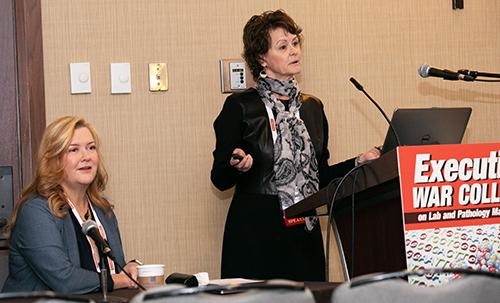World Economic Forum Publishes Updated List of 12 Breakthroughs in Fight against Cancer That Includes Innovative Clinical Laboratory Test (Part 2)
These advances in the battle against cancer could lead to new clinical laboratory screening tests and other diagnostics for early detection of the disease
As Dark Daily reported in part one of this story, the World Economic Forum (WEF) has identified 12 new breakthroughs in the fight against cancer that will be of interest to pathologists and clinical laboratory managers.
As we noted in part one, the WEF originally announced these breakthroughs in an article first published in May 2022 and then updated in October 2024. According to the WEF, the World Health Organization (WHO) identified cancer as a “leading cause of death globally” that “kills around 10 million people a year.”
The WEF is a non-profit organization base in Switzerland that, according to its website, “engages political, business, academic, civil society and other leaders of society to shape global, regional and industry agendas.”
Monday’s ebrief focused on four advances identified by WEF that should be of particular interest to clinical laboratory leaders. Here are the others.
Personalized Cancer Vaccines in England
The National Health Service (NHS) in England, in collaboration with the German pharmaceutical company BioNTech, has launched a program to facilitate development of personalized cancer vaccines. The NHS Cancer Vaccine Launch Pad will seek to match cancer patients with clinical trials for the vaccines. The Launch Pad will be based on messenger ribonucleic acid (mRNA) technology, which is the same technology used in many COVID-19 vaccines.
The BBC reported that these cancer vaccines are treatments, not a form of prevention. BioNTech receives a sample of a patient’s tumor and then formulates a vaccine that exposes the cancer cells to the patient’s immune system. Each vaccine is tailored for the specific mutations in the patient’s tumor.

“I think this is a new era. The science behind this makes sense,” medical oncologist Victoria Kunene, MBChB, MRCP, MSc (above), trial principal investigator from Queen Elizabeth Hospital Birmingham (QEHB) involved in an NHS program to develop personalized cancer vaccines, told the BBC. “My hope is this will become the standard of care. It makes sense that we can have something that can help patients reduce their risk of cancer recurrence.” These clinical trials could lead to new clinical laboratory screening tests for cancer vaccines. (Photo copyright: Queen Elizabeth Hospital Birmingham.)
Seven-Minute Cancer Treatment Injection
NHS England has also begun treating eligible cancer patients with under-the-skin injections of atezolizumab, an immunotherapy marketed under the brand name Tecentriq, Reuters reported. The drug is usually delivered intravenously, a procedure that can take 30 to 60 minutes. Injecting the drug takes just seven minutes, Reuters noted, saving time for patients and cancer teams.
The drug is designed to stimulate the patient’s immune system to attack cancer cells, including breast, lung, liver, and bladder cancers.
AI Advances in India
One WEF component—the Center for the Fourth Industrial Revolution (C4IR)—aims to harness emerging technologies such as artificial intelligence (AI) and virtual reality. In India, the organization says the Center is seeking to accelerate use of AI-based risk profiling to “help screen for common cancers like breast cancer, leading to early diagnosis.”
Researchers are also exploring the use of AI to “analyze X-rays to identify cancers in places where imaging experts might not be available.”
Using AI to Assess Lung Cancer Risk
Early-stage lung cancer is “notoriously hard to detect,” WEF observed. To help meet this challenge, researchers at Massachusetts Institute of Technology (MIT) developed an AI model known as Sybil that analyzes low-dose computed tomography scans to predict a patient’s risk of getting the disease within the next six years. It does so without a radiologist’s intervention, according to a press release.
The researchers tested the system on scans obtained from the National Lung Cancer Screening Trial, Mass General Hospital (MGH), and Chang Gung Memorial Hospital. Sybil achieved C-index scores ranging from 0.75 to 0.81, they reported. “Models achieving a C-index score over 0.7 are considered good and over 0.8 is considered strong,” the press release notes.
The researchers published their findings in the Journal of Clinical Oncology.
Using Genomics to Identify Cancer-Causing Mutations
In what has been described as the “largest study of whole genome sequencing data,” researchers at the University of Cambridge in the UK announced they have discovered a “treasure trove” of information about possible causes of cancer.
Using data from England’s 100,000 Genomes Project, the researchers analyzed the whole genome sequences of 12,000 NHS cancer patients.
This allowed them “to detect patterns in the DNA of cancer, known as ‘mutational signatures,’ that provide clues about whether a patient has had a past exposure to environmental causes of cancer such as smoking or UV light, or has internal, cellular malfunctions,” according to a press release.
The researchers also identified 58 new mutational signatures, “suggesting that there are additional causes of cancer that we don’t yet fully understand,” the press release states.
The study appeared in April 2022 in the journal Science.
Validation of CAR-T-Cell Therapy
CAR-T-cell therapy “involves removing and genetically altering immune cells, called T cells, from cancer patients,” WEF explained. “The altered cells then produce proteins called chimeric antigen receptors (CARs), which can recognize and destroy cancer cells.”
The therapy appeared to receive validation in 2022 when researchers at the University of Pennsylvania published an article in the journal Nature noting that two early recipients of the treatment were still in remission after 12 years.
However, the US Food and Drug Administration (FDA) announced in 2023 that it was investigating reports of T-cell malignancies, including lymphoma, in patients who had received the treatment.
WEF observed that “the jury is still out as to whether the therapy is to blame but, as a precaution, the drug packaging now carries a warning.”
Breast Cancer Drug Repurposed for Prevention
England’s NHS announced in 2023 that anastrozole, a breast cancer drug, will be available to post-menopausal women to help reduce their risk of developing the disease.
“Around 289,000 women at moderate or high risk of breast cancer could be eligible for the drug, and while not all will choose to take it, it is estimated that if 25% do, around 2,000 cases of breast cancer could potentially be prevented in England, while saving the NHS around £15 million in treatment costs,” the NHS stated.
The tablet, which is off patent, has been used for many years to treat breast cancer, the NHS added. Anastrozole blocks the body’s production of the enzyme aromatase, reducing levels of the hormone estrogen.
Big Advance in Treating Cervical Cancer
In October 2024, researchers announced results from a large clinical trial demonstrating that a new approach to treating cervical cancer—one that uses currently available therapies—can reduce the risk of death by 40% and the risk of relapsing by 36%.
Patients are commonly treated with a combination of chemotherapy and radiotherapy called chemoradiotherapy (CRT), according to Cancer Research UK. But outcomes are improved dramatically by administering six weeks of induction therapy prior to CRT, the researchers reported.
“This is the biggest improvement in outcome in this disease in over 20 years,” said Mary McCormack, PhD, clinical oncologist at the University College London and lead investigator in the trial.
The scientists published their findings in The Lancet.
Pathologists and clinical lab managers will want to keep track of these 12 breakthrough advancements in the diagnosis and treatment of cancer highlighted by the WEF. They will likely lead to new screening tests for the disease and could save many lives.
—Stephen Beale
Related Information:
Thousands of Cancer Patients to Trial Personalized Vaccines
England to Rollout World-First Seven-Minute Cancer Treatment Jab
MIT Researchers Develop an AI Model That Can Detect Future Lung Cancer Risk
Largest Study of Whole Genome Sequencing Data Reveals New Clues to Causes of Cancer
Tens of Thousands of Women Set to Benefit from ‘Repurposed’ NHS Drug to Prevent Breast Cancer
Cervical Cancer Treatment Breakthrough Cuts Risk of Death By 40%




